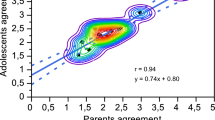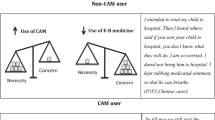Abstract
Background The association between parental attitudes and medication administered to their children has been studied mainly regarding specific diseases and ailments, e.g. asthma, fever and pain. Little is known about how parental attitudes toward medicines in general are associated with how they medicate their children using self-medication. Objective The aim of this study was to identify how parental attitudes toward medicines are associated with how they medicate their children with self-medication including the use of over-the-counter (OTC) medicines and complementary and alternative medicines (CAMs). Setting A cross-sectional population-based study was conducted in the spring of 2007. The study sample consisted of a random sample of Finnish children under 12 years of age (n = 6,000). Method A questionnaire was sent to parents, and the parent who usually takes responsibility for the child´s medication was instructed to answer the questionnaire. Main outcome measure The responding parent was asked to report the child’s use of OTC medicines and CAMs during the preceding 2 days. The parent’s attitude toward medicines was measured by 18 statements using a 5-item Likert scale. Results CAM use was least likely among children whose parent had a positive view of prescription medicines. In contrast, a positive attitude toward OTC medicines by a parent was associated with both, OTC medicine and CAM use among children, whereas, parental worry about the risks of medicines predicted the use of CAMs among children. Conclusion This study showed that parental attitudes toward medicines have an impact on how they medicate their children, especially with CAMs. This finding highlights the fact that health care professionals should negotiate a child’s treatment, taking into account parental views toward medicines, and previous use of self-medication.
Similar content being viewed by others
References
Gerrits T, Haaijer-Ruskamp F, Hardon AP. “Preferably half a tablet” health-seeking behavior when dutch children get ill. In: Bush PJ, Trakas DJ, Sanz EJ, Wirsing RL, Vaskilampi T, Prout A, editors. Children, medicines, and culture. (New York, London): Pharmaceutical Products Press 1996. p. 209–224. ISBN L-56024-937-4.
World Health Organization (WHO) [internet]. The role of the pharmacist in self-care and self-medication. Report of the 4th WHO consultative group on the role of the pharmacist. Hague, The Neterlands, 26–28 August, 1998. Department of Essencial Drugs and Other Medicines, World Health Organization. 2012. Available from: http://www.opas.org.br/medicamentos/site/UploadArq/who-dap-98-13.pdf.
Eisenberg DM, Davis RB, Ettner SL, Appel S, Wilkey S, Van Rompay M, et al. Trends in alternative medicine use in the United States, 1990–1997. Results of a follow-up national survey. JAMA. 1998;280(18):1569–75.
Menniti-Ippolito F, Gargiulo L, Bologna E, Forcella E, Raschetti R. Use of unconventional medicine in Italy: a nation-wide survey. Eur J Clin Pharmacol. 2002;58:61–4.
Reinstein JA. Worldwide trend in self-medication. Dosis. 2005;21(2):88–96.
Barnes PM, Bloom B, Nahin RL. Complementary and alternative medicine use among adults and children: United States, 2007 national health statistics reports; no 12. Hyattsville: National Center for Health Statistics; 2008.
O’Keefe M, Coat S. Increasing health-care options: the perspectives of parents who use complementary and alternative medicines. J Paediatr Child Health. 2010;46(6):296–300.
Ylinen S, Hämeen-Anttila K, Sepponen K, Lindblad AK, Ahonen R. The use of prescription medicines and self-medication among children- a population-based study in Finland. Pharmacoepidemiol Drug Saf. 2010;19(10):1000–8.
National Centre for Complementary and Alternative Medicine (NCCAM) [internet]. What is complementary and alternative medicine? c2011. 2012. Available from: http://nccam.nih.gov/health/whatiscam/.
Isacson D, Bingefors K. Attitudes towards drugs—a survey in the general population. Pharm World Sci. 2002;24(2):104–10.
Dolovich L, Nair K, Sellors C, Lohfeld L, Lee A, Levine M. Do patients’ expectations influence their use of medications? Can Fam Physician. 2008;54:384–93.
Britten N. Patients’ ideas about medicines: a qualitative study in general practice population. Br J Gen Pract. 1994;44(387):465–8.
Gatti ME, Jacobson KL, Gazmararian JA, Schmotzer B, Kripalani S. Relationships between beliefs about medications and adherence. Am J Health Syst Pharm. 2009;66(7):657–64.
Simpson N, Roman K. Complementary medicine use in children: extent and reasons. A population-based study. Br J Gen Pract. 2001;51:914–6.
Lynch N, Berry D. Differences in perceived risks and benefits of herbal, over-the-counter conventional, and prescribed conventional, medicines, and the implications of this for the safe and effective use of herbal products. Complement Ther Med. 2007;15:84–91.
Huillet A, Erdie-Lalena C, Norvell D, Davis BE. Complementary and alternative medicine used by children in military pediatric clinics. J Altern Complement Med. 2011;17(6):531–7.
Nichol J, Thompson EA, Shaw A. Beliefs, decision-making, and dialogue about complementary and alternative medicine (CAM) within families using CAM: a qualitative study. J Altern Complement Med. 2011;17(2):117–25.
Finley GA, McGrath PJ, Forward SP, McNeill G, Fitzgerald P. Parents’ management of children’s pain following’minor’ surgery. Pain. 1996;64:83–7.
Forward SP, Brown TL, McGrath PJ. Mothers’ attitudes and behavior toward medicating children’s pain. Pain. 1996;67:469–74.
Ecklund CR, Ross MC. Over-the-counter medication use in preschool children. J Pediatr Health Care. 2001;15:168–72.
Kankkunen PM, Vehviläinen-Julkunen KM, Pietilä AMK, Kokki H, Grey M, Kain ZN, et al. A tale of two countries: comparison of the perceptions of analgesics among finnish and American parents. Pain Manag Nurs. 2008;9(3):113–9.
Jensen JF, Tønnessen LL, Söderström M, Thorsen H, Siersma V. Paracetamol for feverish children: parental motives and experiences. Scand J Prim Health Care. 2010;28(2):115–20.
Rony RYZ, Fortier MA, Chorney JM, Perret D, Kain ZN. Parental postoperative pain management: attitudes, assessment, and management. Pediatrics. 2010;125(6):e1372–8.
Wood D, Finlay F. Complementary and alternative medicine use in children with life-limiting conditions. Nurs Child Young People. 2011;23(4):31–4.
Zuzak TJ, Zuzak-Siegrist I, Simões-Wüst AP, Rist L, Staubli G. Use of complementary and alternative medicine by patients presenting to a paediatric emergency department. Eur J Pediatr. 2009;168:431–7.
Conn KM, Halterman JS, Fisher SG, Yoos HL, Chin NP, Szilagyi PG. Parental beliefs about medications and medication adherence among urban children with asthma. Ambul Pediatr. 2005;5:306–10.
Conn KM, Halterman JS, Lynch K, Cabana MD. The impact of parents’ medication beliefs on asthma management. Pediatrics. 2007;120(3):521–6.
Koster ES, Wijga AH, Koppelman GH, Postma DS, Brunekreef B, Jongste JCD, et al. Uncontrolled asthma at age 8: the importance of parental perception towards medication. Pediatr Allergy Immunol. 2011;22:462–8.
Maiman LA, Becker MH, Cummings KM, Draghman RH, O’Connor PA. Effects of socio demographic and attitudinal factors on mother-initiated medication behavior for children. Public Health Rep. 1982;97(2):141–9.
Halim M, Vincent H, Saini B, Hämeen-Anttila K, Vainio K, Moles R. Validating the children’s medicines use questionnaire (CMUQ) in Australia. Pharm World Sci. 2010;32:81–9.
Hämeen-Anttila K, Halonen P, Siponen S, Holappa M, Ahonen R. Parental attitudes toward medicine use in children in Finland. Int J Clin Pharm. 2011;33(5):849–58.
Klaukka T, Martikainen J, Kalimo E. Drug Utilization in Finland 1964–1987. Helsinki: Publications of the Social Insurance Institution; 1990. ISBN 951-669-304-0.
Arinen S, Häkkinen U, Klaukka T, Klavus J, Lehtonen R. Health and the Use of Health Services in Finland: main findings of the Finnish Health Care Survey 1995/96 and changes from 1987. Helsinki: Stakes and Kela, SVT Health Care; 1998. ISBN 951-33-0764-6.
National Institute for Health and Welfare [internet]. D-vitamiinivalmisteiden käyttösuositukseen muutoksia. c2011. 2012. Available from: http://www.thl.fi/doc/fi/23892.
Birchley N, Conroy S. Parental management of over-the-counter medicines. Pediatr Nurs. 2002;14(9):24–8.
Furnham A. Exploring attitudes toward, and knowledge of, homeopathy and CAM through focus groups. Complement Ther Nurs Midwifery. 2002;8:42–7.
Kogan MD, Pappas G, Yu SM, Kotelchuck M. Over-the-counter medication use among US preschool-age children. JAMA. 1994;272(13):1025–30.
Maison P, Guillemot D, Vauzelle-Kervroëdan F, Balkau B, Sermet C, Thibult N, et al. Trends in aspirin, paracetamol and non-steroidal anti-inflammatory drug use in children between 1981 and 1992 in France. Eur J Clin Pharmacol. 1998;54:659–64.
Low E, Murray DM, O’Mahony O, O’B Hourihane J. Complementary and alternative medicine use in Irish paediatric patients. Ir J Med Sci. 2008;177:147–50.
Birdee GS, Phillips RS, Davis RB, Gardiner P. Factors associated with pediatric use of complementary and alternative medicine. Pediatrics. 2010;125:249–56.
Acknowledgments
We want to thank research assistants Paula Räsänen and Seija Pirhonen for their valuable help during the data collection process.
Funding
No external funding was received for this study. All the costs were covered by the Department of Pharmacy, University of Eastern Finland.
Conflicts of interest
The authors do not have any conflicts of interests.
Author information
Authors and Affiliations
Corresponding author
Rights and permissions
About this article
Cite this article
Siponen, S., Ahonen, R., Kiviniemi, V. et al. Association between parental attitudes and self-medication of their children. Int J Clin Pharm 35, 113–120 (2013). https://doi.org/10.1007/s11096-012-9715-2
Received:
Accepted:
Published:
Issue Date:
DOI: https://doi.org/10.1007/s11096-012-9715-2




